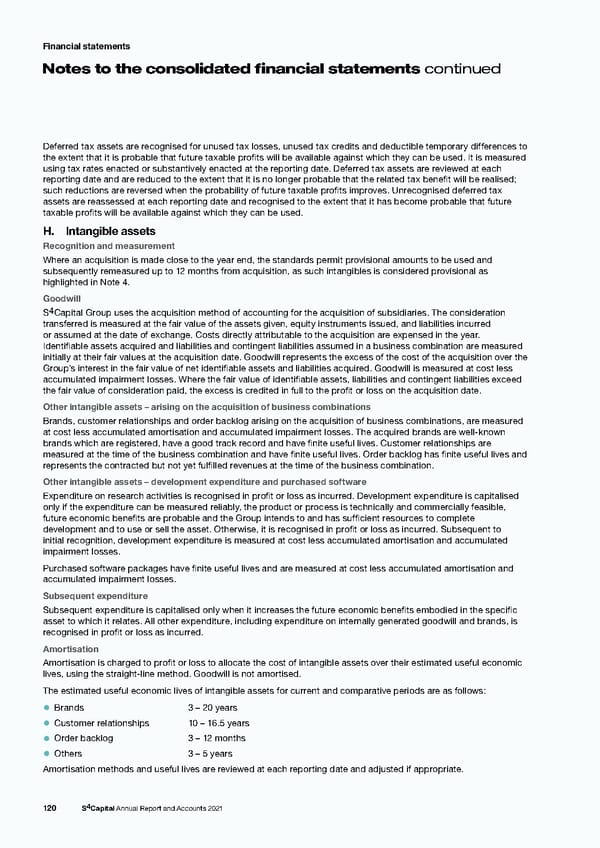Financial statements N otes to the consolidated financial statements continued Deferred tax assets are recognised for unused tax losses, unused tax credits and deductible temporary differences to the extent that it is probable that future taxable profits will be available against which they can be used. It is measured using tax rates enacted or substantively enacted at the reporting date. Deferred tax assets are reviewed at each reporting date and are reduced to the extent that it is no longer probable that the related tax benefit will be realised; such reductions are reversed when the probability of future taxable profits improves. Unrecognised deferred tax assets are reassessed at each reporting date and recognised to the extent that it has become probable that future taxable profits will be available against which they can be used. H. Intangible assets Recognition and measurement Where an acquisition is made close to the year end, the standards permit provisional amounts to be used and subsequently remeasured up to 12 months from acquisition, as such intangibles is considered provisional as highlighted in Note 4. Goodwill S4Capital Group uses the acquisition method of accounting for the acquisition of subsidiaries. The consideration transferred is measured at the fair value of the assets given, equity instruments issued, and liabilities incurred or assumed at the date of exchange. Costs directly attributable to the acquisition are expensed in the year. Identifiable assets acquired and liabilities and contingent liabilities assumed in a business combination are measured initially at their fair values at the acquisition date. Goodwill represents the excess of the cost of the acquisition over the Group’s interest in the fair value of net identifiable assets and liabilities acquired. Goodwill is measured at cost less accumulated impairment losses. Where the fair value of identifiable assets, liabilities and contingent liabilities exceed the fair value of consideration paid, the excess is credited in full to the profit or loss on the acquisition date. Other intangible assets – arising on the acquisition of business combinations Brands, customer relationships and order backlog arising on the acquisition of business combinations, are measured at cost less accumulated amortisation and accumulated impairment losses. The acquired brands are well-known brands which are registered, have a good track record and have finite useful lives. Customer relationships are measured at the time of the business combination and have finite useful lives. Order backlog has finite useful lives and represents the contracted but not yet fulfilled revenues at the time of the business combination. Other intangible assets – development expenditure and purchased software Expenditure on research activities is recognised in profit or loss as incurred. Development expenditure is capitalised only if the expenditure can be measured reliably, the product or process is technically and commercially feasible, future economic benefits are probable and the Group intends to and has sufficient resources to complete development and to use or sell the asset. Otherwise, it is recognised in profit or loss as incurred. Subsequent to initial recognition, development expenditure is measured at cost less accumulated amortisation and accumulated impairment losses. Purchased software packages have finite useful lives and are measured at cost less accumulated amortisation and accumulated impairment losses. Subsequent expenditure Subsequent expenditure is capitalised only when it increases the future economic benefits embodied in the specific asset to which it relates. All other expenditure, including expenditure on internally generated goodwill and brands, is recognised in profit or loss as incurred. Amortisation Amortisation is charged to profit or loss to allocate the cost of intangible assets over their estimated useful economic lives, using the straight-line method. Goodwill is not amortised. The estimated useful economic lives of intangible assets for current and comparative periods are as follows: • Brands 3 – 20 years • Customer relationships 10 – 16.5 years • Order backlog 3 – 12 months • Others 3 – 5 years Amortisation methods and useful lives are reviewed at each reporting date and adjusted if appropriate. 120 S4Capital Annual Report and Accounts 2021
 s4 capital annual report and accounts 2021 Page 121 Page 123
s4 capital annual report and accounts 2021 Page 121 Page 123